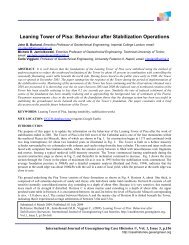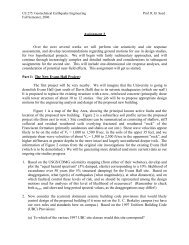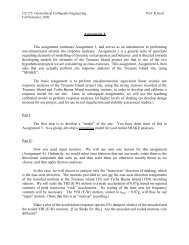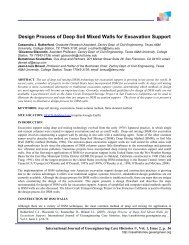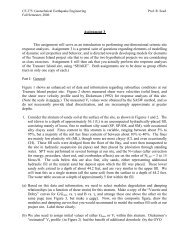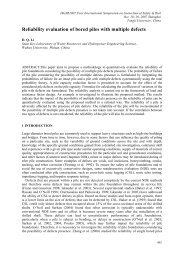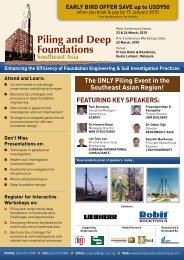Risk Assessment and Management for Offshore ... - GEOSNet
Risk Assessment and Management for Offshore ... - GEOSNet
Risk Assessment and Management for Offshore ... - GEOSNet
Create successful ePaper yourself
Turn your PDF publications into a flip-book with our unique Google optimized e-Paper software.
transport on continental margins. Submarine slides can be triggered by natural geological<br />
processes or by human-induced changes. Large scale, long-term geological processes need to be<br />
understood <strong>and</strong> incorporated in petroleum exploration activities <strong>and</strong> are often of vital importance<br />
<strong>for</strong> geohazard evaluations. On a global basis, plate tectonics controls the development of<br />
continental shelves <strong>and</strong> margins. Long term environmental changes with a period of about<br />
100,000 years caused major glaciations repeatedly during the last 900,000 year. The shift between<br />
the interglacial sea level high-st<strong>and</strong> <strong>and</strong> the glacial sea level low-st<strong>and</strong> periods, with more than<br />
100 m change in the sea level, have had a significant impact on the development of continental<br />
shelves <strong>and</strong> slopes (Solheim et al., 2007).<br />
Fig.1 Potential geohazards on deepwater margins.<br />
2 CHARACTERISTICS OF SUBMARINE SLIDES<br />
Submarine slides are common <strong>and</strong> very effective mechanisms of sediment transfer from the shelf<br />
<strong>and</strong> upper slope to deep-sea basins (Hampton et al., 1996; Locat <strong>and</strong> Lee, 2002; Syvitsky et al.,<br />
1987). During one single event enormous sediment volumes can be transported on very gentle<br />
slopes with inclinations in the range 0.5 to 3°, over distances exceeding hundreds of kilometres.<br />
Typically such events last from less than an hour to several days <strong>and</strong> can severely damage fixed<br />
plat<strong>for</strong>ms, pipelines, submarine cables <strong>and</strong> other seafloor installations. Research on underst<strong>and</strong>ing<br />
the mechanisms behind <strong>and</strong> the risks posed by submarine slides has intensified in the past decade,<br />
mainly because of the increasing number of deep-water petroleum fields that have been<br />
discovered <strong>and</strong> in some cases developed (Locat <strong>and</strong> Mienert, 2003). Production from offshore<br />
fields in areas with earlier sliding activity is ongoing in the Norwegian margin, Gulf of Mexico,<br />
offshore Brazil, the Caspian Sea <strong>and</strong> West Africa.<br />
Submarine l<strong>and</strong>slides occur frequently on both passive <strong>and</strong> active continental margins,<br />
especially on the continental slopes. Despite the generally low slope angles, these are areas of<br />
sloping stratigraphy, often with more active <strong>and</strong> vigorous geological processes, including<br />
seismicity, than those found in the shallow, sub-horizontal continental shelf areas. The shelf edge<br />
<strong>and</strong> slope area contain the most recently deposited materials, <strong>and</strong> in areas with high deposition<br />
rate, underconsolidation / excess pore pressure may exist. The excess pore pressure often plays a<br />
major role in destabilization of submarine slopes. The expenses of finding <strong>and</strong> developing new<br />
fields in deep water are very high, <strong>and</strong> this greatly increases the economic consequence part of the<br />
risk aspect connected to submarine slides in the continental margin settings.<br />
The assessment of the risk associated with submarine mass movements is thus not just a matter<br />
related to commercial interests of oil companies. The societal <strong>and</strong> environmental consequences of<br />
such events could also be enormous <strong>for</strong> coastal communities. For instance, large submarine slides<br />
160



